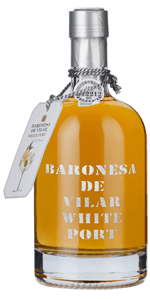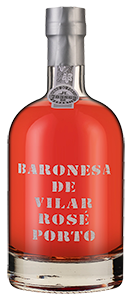Filter by
- White port given a modern makeover by a top Douro family. A perfect base for a sundown cocktail£11.99 per bottleSAVE £1.00
- £60.00 per bottle
- A very fragrant, pretty style of port, full of summer berries. Chilled in summer, a real delight£10.99 per bottleSAVE £2.00
- Showing (1 to 3 of 3)
1
Page 1 of 1
What is Port wine?
Port wine is a fortified wine produced northern Portugal’s scenic Douro Valley.
It’s often served with dessert or after dinner due to its signature richness – and comes in a variety of styles, including dry, off-dry, sweet and white.
Port is usually made by fortifying blended Portuguese red wine with a neutral grape spirit. The base wine is usually produced by blending six varieties of red grapes found in the Douro Valley. These include:
- Touriga Nacional: The backbone of many fine Ports, it lends depth and complexity with dark fruit flavours.
- Tinta Roriz (Tempranillo): Offers spiciness and berry flavours, adding finesse and balance to Port blends.
- Touriga Franca: This grape brings bright red fruit and a perfumed elegance to the blend.
- Tinta Barroca: Its soft, sweet fruit character balances Port blends with softer, rounder notes.
- Tinta Cão: Offers vibrant acidity and floral undertones, playing a role in the longevity and freshness of Port wines.
- Tinta Amarela: This grape adds complexity and elegance to Port wine blends with its fragrant aromas of red fruits and spices.
What styles of Port wine are there?
Port wine is available in various styles, but the four most common are Ruby, Tawny, Rosé and White.
Ruby Port – Young, fruity, and vibrant, with deep crimson hues. This style also includes Vintage, Late-Bottled Vintage (LBV), and Crusted Port, all aged for different lengths of time to produce more complex flavours.
Tawny Port – Aged in wooden barrels, this wine develops a golden-brown colour with nuts, dried fruits, and caramel flavours. Age labels – 10, 20, 30, 40 years – signify the wine’s character rather than its precise age.
White Port – Made using native Portuguese grapes like Rabigato, Viosinho, Gouveio, and Malvasia. White Port is made in a range of styles and sweetness levels, from bone-dry to lusciously sweet.
Rosé Port – The newest style and technically a Ruby Port, it is produced in a similar style to rosé wine – with the red grape skins having minimal contact to produce a pretty shade of pink.
What does Port taste like?
Part of the magic of Port is that each style and vintage comes with its own character. But, Port’s core flavours are often described as sweet, luxurious and ripe, with medium tannins offering a hint of bitterness underneath.
Ruby Port wines are bursting with flavours like raspberry, blackberry, caramel, cinnamon and chocolate, offering wine drinkers something indulgent and moreish. Tawny Port has some similar flavours, like raspberry, cinnamon and caramel, but the additional ageing in wooden barrels adds hazelnut, clove and fig.
Like rosé wine, Rosé Port also has bright flavours of raspberry, strawberry and cranberry sauce flavours. As White Port is made with different grapes than Port’s traditional six-grape blend, it has an entirely different flavour profile, characterised by citrus, sweet fruits like apricot and baked apple, and sweet toasted nuts.
What foods pair well with Port?
Because of its sweetness and intense fruit flavours, Port is a great match for a variety of dishes.
- Ruby and LBV Ports: match their fruitiness with blue cheeses or decadent chocolate desserts.
- Tawny Port: ideal with nutty desserts, creamy cheeses or caramel tarts.
- White Port: a great choice with seafood dishes, almonds or as an aperitif with olives.
To ensure you enjoy Port at its best, it’s important to serve it at the correct temperature:
- Rosé Port: best served chilled – we’d recommend around 6°C.
- White Port: best served lightly chilled – between10-12°C.
- LBV Port: best served slightly cooler than room temperature – between 14-16°C.
- Ruby and Tawny Port: best served just below room temperature – around 16°C.
Port’s intense flavours and high alcohol levels means it’s typically served in small measures in dessert wine or special Port wine glasses. These have long stems, but short, tulip-shaped bowls perfectly suited to Port’s complex aromas.
How long does Port last?
We’ve all been guilty of leaving a bottle of Port on a sideboard, but follow these simple rules of thumb and you’ll keep your wine in top drinking condition.
- Ruby and LBV (Late Bottled Vintage) Port – Once opened, these vibrant and fruity styles can maintain their character for up to two weeks, if they’re resealed and stored in a cool, dark place.
- Tawny Port – Aged Tawny Ports have already been exposed to some air during their time in wooden barrels. This exposure gives them the ability to last slightly longer once opened. We suggest enjoying an opened bottle within three weeks for optimum flavour.
- White and Rosé Port – These lighter styles, once uncorked, should be finished within a week to ten days. To keep their freshness and aromatic profiles, it’s best to pop them in the fridge.
- Vintage Port – The complexity and depth of Vintage Port is easily tainted by the air once it’s opened. So, gather friends and family to finish the full bottle within two to three days.
Here are some handy Port storage tips:
- Always reseal the bottle with its original cork or a wine stopper.
- Store the bottle upright to minimise surface area exposed to oxygen.
- If you don’t plan on finishing the bottle soon after opening, consider transferring the wine to a smaller bottle or using a wine preservation system to minimise oxidation.
What are the best Port wines for Christmas?
Andresen Port house was founded in 1845 – and today, they remain one of the few 100% family-owned Portuguese Port houses. They have built a stellar reputation based on using an ultra-rigorous grape selection to make only the finest wines. We’ve got two that are perfect for Christmas:
The youngest and fruitiest style of Port – Andresen’s Ruby is seductively luscious with figgy notes, powerful red fruit flavours and a long, juicy finish. A great tipple to enjoy after your Christmas dinner – either on its own or with mature Stilton.
Andresen Late Bottled Vintage Port
Andresen’s Late Bottled Vintage Port is renowned its level of concentration and richness – it can rival even the most expensive Vintage ports. This is rich, lavish and complex, with warming blackcurrant, chocolate, spice and tobacco flavours and hazelnut aromas. Decant an hour before drinking. The ultimate after-dinner treat.
From the famous house of Fonseca, this is an intense, velvety port made in a similar style to LBV. Made from various vintages and long aged in wood, expect seductively mouthfuls of intense blackberry, cherry and plum rippled with mocha and spice. Pair with dessert – especially a dark chocolate torte or cheeses.
What are our best vintage Ports?
Vintage Ports often take 20 years of cellaring to reach their peak. Luckily, Late Bottled Vintage Ports are a smart alternative.
They are similar in style … but matured in cask for longer. This allows you to enjoy their luxuriously rich, warming, raisin and plum flavours right away.
Andresen’s LBV has levels of concentration and richness that can rival even the most expensive vintage ports. It’s unfiltered to retain every element of flavour and colour from the wine, resulting in lavish and complex flavours. Expect warming blackcurrant, chocolate and spice flavours, with dark plum and hazelnut aromas.
Can I send Port as a gift?
Yes, you can send Port wine as a gift.
Whether you want to send a single bottle of wine or a gift set, we have wine gifts for birthdays, weddings, anniversaries and more.
When will my Port wine be delivered?
The date of your Port wine delivery will depend on which option you choose at checkout. We offer:
Standard delivery is ideal if you’re buying for yourself or as a thank you gift. We’ll deliver your order within three working days.
Next-day delivery is a great choice for last-minute gifts, while Named-day delivery is perfect for anniversaries, birthdays and special occasions. Do bear in mind that we don’t deliver on Sundays or Bank Holidays.
Top tip: for the best experience, subscribe to our Unlimited service. You’ll make a one-off payment of £29.99 which entitles you to free delivery for a year – as often as you like – even on single bottles.









